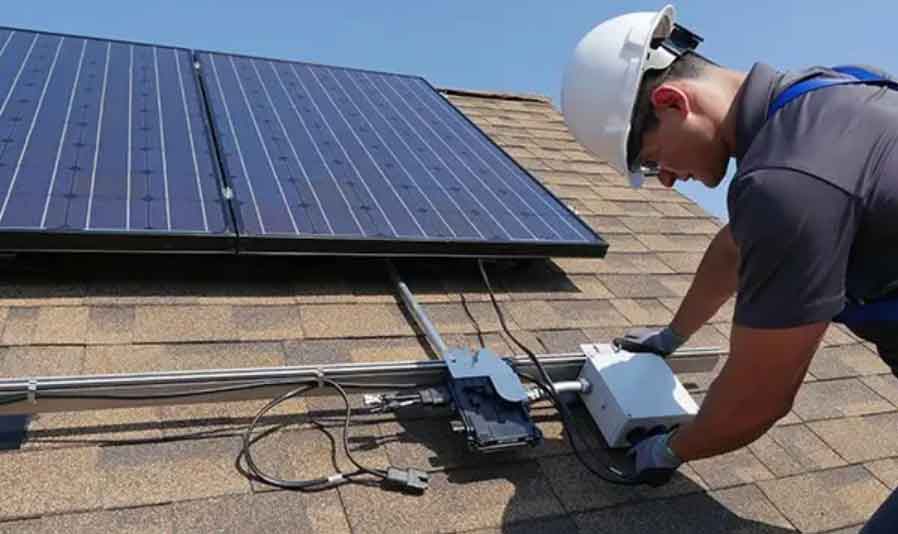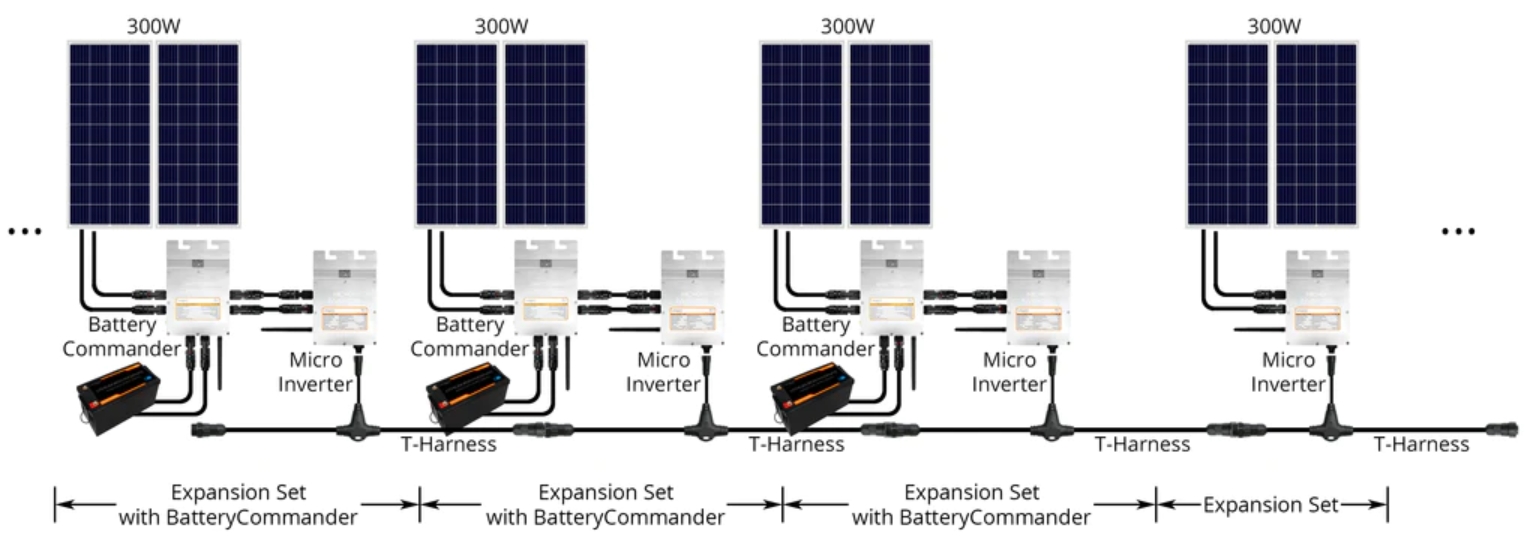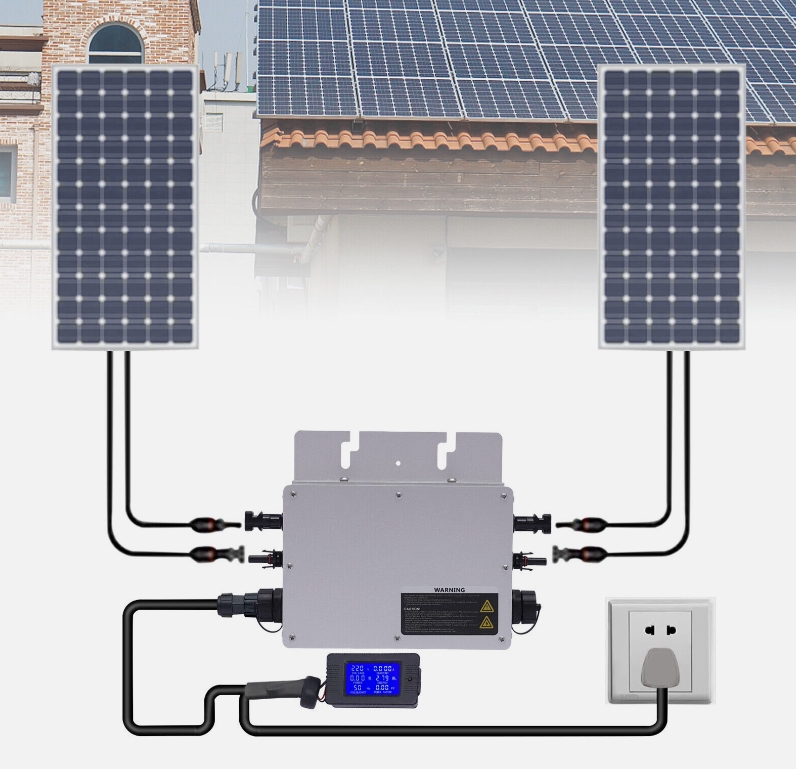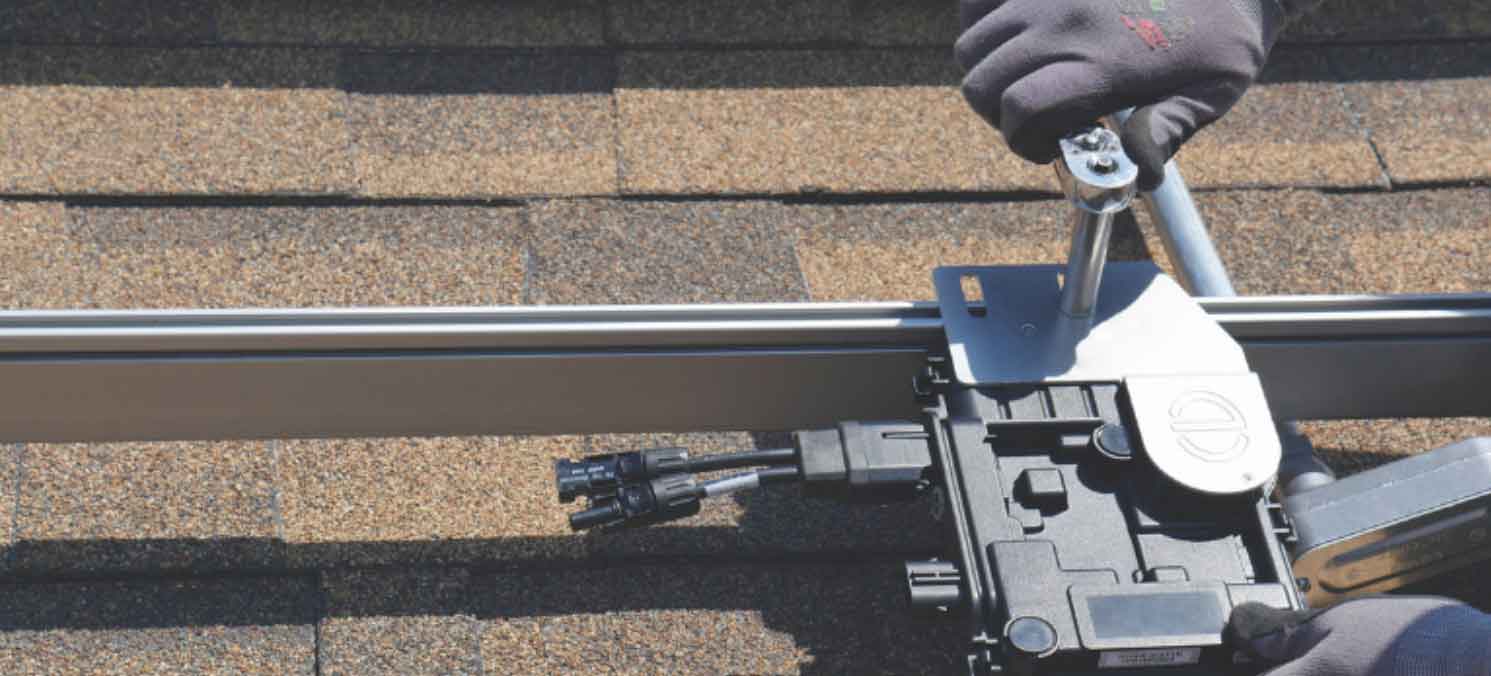Chapter 1: The Future of Solar Panels with Micro Inverters

The future of solar energy is continually evolving with technological advancements. Solar panels with micro inverters are a significant part of this evolution. Here’s a brief overview:
- Micro Inverters Explained: Traditional solar panel systems use a single, central inverter to convert the direct current (DC) produced by the solar panels with micro inverters into alternating current (AC) for use in homes and businesses. Micro inverters, on the other hand, are small inverters attached to each solar panels with micro inverters. This design allows each panel to operate independently.
- Advantages:
- Increased Efficiency: Micro inverters can optimize the output of each individual panel, which is particularly useful if some panels are shaded or operating at different efficiencies.
- Enhanced Monitoring: They allow for more detailed monitoring of each panel’s performance, enabling quicker identification and resolution of any issues.
- Longer Lifespan: Micro inverters typically have a longer lifespan than central inverters.
- Safety: They reduce the high DC voltage to a safer AC voltage at each panel, decreasing the risk of high-voltage DC accidents.
- Cost Consideration: While micro inverters are more expensive upfront compared to traditional inverters, their benefits can often offset the initial cost over time through increased energy production and less maintenance.
- Future Trends:
- Integration with Smart Grids: Micro inverters are well-suited for integration into smart grid technology, allowing for better energy management and distribution.
- Advancements in Technology: Ongoing advancements in micro inverter technology are expected to reduce costs and improve efficiency and reliability.
- Increased Adoption: As the benefits of micro inverters become more widely recognized, their adoption in both residential and commercial solar installations is likely to grow.
- Environmental Impact: The increased efficiency and potential for longer system life with micro inverters contribute to a more sustainable and environmentally friendly solar panels with micro inverters production.
- Energy Independence: By maximizing solar panels with micro inverters efficiency, micro inverters can play a significant role in moving towards energy independence and reducing reliance on fossil fuels.
In conclusion, the integration of micro inverters into solar panels with micro inverters represents a significant step forward in solar technology, offering improved efficiency, safety, and monitoring capabilities. As technology continues to advance, we can expect even more innovative solutions in the solar energy sector.
Chapter 2: The Rise of Solar Panels with Micro Inverters
The rise of solar panels with micro inverters equipped with micro inverters marks a significant shift in the solar energy industry, aimed at harnessing greater efficiency and adaptability. Here’s an in-depth look at this trend:
- Technology Overview: Micro inverters represent a shift from traditional centralized inverter systems. Each solar panels with micro inverters in a micro inverter system operates independently, converting DC to AC electricity right at the panel. This is a major departure from systems where multiple panels are connected in a series to a single, central inverter.
- Efficiency Gains: One of the primary benefits of micro inverters is their ability to maximize the efficiency of each individual solar panels with micro inverters. In traditional systems, the performance of the entire array can be dragged down by a single underperforming panel (due to shading, debris, or damage). Micro inverters eliminate this issue, ensuring that each panel operates at its peak.
- Improved Durability and Longevity: Micro inverters are typically more durable and have a longer lifespan than central inverters. This is partly because they are not exposed to as high power and heat loads as central inverters. Longer lifespan not only reduces maintenance costs but also enhances the return on investment for solar installations.
- Enhanced Monitoring and Management: Each micro inverter can be monitored individually, which provides detailed insights into the performance of each panel. This makes it easier to identify and address issues, leading to more efficient maintenance and management of the solar array.
- Safety Benefits: With micro inverters, the high DC voltage is converted to AC at each panel, significantly reducing the risk of high-voltage DC accidents. This makes the system inherently safer, both during installation and operation.
- Cost and Market Trends: Initially, micro inverters are more expensive than standard inverters. However, their benefits often justify the higher upfront cost. As technology advances, the cost is expected to decrease. The market for micro inverters is expanding, with increasing adoption in both residential and commercial solar panels with micro inverters.
- Future Innovations: The solar panels with micro inverters is rapidly evolving, and future advancements in micro inverter technology are likely to focus on increasing efficiency, reducing costs, and integrating with smart grid technologies. This could include advancements in energy storage integration, further enhancing the appeal of solar panels with micro inverters.
- Global Impact and Sustainability: As the world moves towards renewable energy sources, technologies like micro inverters that optimize energy production play a crucial role. They contribute to the global effort of reducing carbon footprints and achieving sustainability goals.
The adoption of solar panels with micro inverters signifies an important progression in solar technology. They offer numerous advantages including increased efficiency, enhanced safety, and better system monitoring, positioning them as a key component in the future landscape of renewable energy. This technology aligns with global efforts towards more sustainable and efficient energy solutions, marking a promising trend in the field of solar energy.
Chapter 3:The Advantages of Using Solar Panels with Micro Inverters

Using solar panels with micro inverters offers several advantages:
- Increased Energy Efficiency: Micro inverters optimize the power output from each solar panels with micro inverters individually. This means if one panel is shaded or underperforming, it doesn’t affect the performance of other panels in the array. This results in a more efficient overall system.
- Improved System Reliability: Since each panel operates independently, the failure of one panel or inverter doesn’t bring down the entire system. This redundancy enhances the reliability of solar panels with micro inverters.
- Enhanced Safety: Micro inverters convert the DC electricity generated by solar panels with micro inverters into AC electricity at the panel site. This reduces the risk of high-voltage DC electricity being transmitted across your roof, which can be a fire hazard.
- Easier Installation and Expansion: Systems with micro inverters are generally easier to install. They also offer more flexibility for expansion, as you can add panels without needing to match them to the existing ones or reconfigure the entire system.
- Detailed Monitoring: Micro inverters typically come with advanced monitoring capabilities, allowing you to track the performance of each individual panel. This makes it easier to identify and troubleshoot any issues.
- Longer Warranties: Micro inverters often have longer warranties compared to traditional string inverters. This could mean a longer lifespan and better reliability for solar panels with micro inverters.
- Shade Tolerance: In a system with a traditional string inverter, shading on one panel can affect the output of all panels in the string. Micro inverters mitigate this problem by isolating the impact of shading to the affected panel only.
- Design Flexibility: With micro inverters, you have more freedom in designing solar panels with micro inverters layout. They allow for installation at varying angles and orientations, which is beneficial for complex or irregular roof shapes.
These advantages make micro inverters an appealing option for many residential and commercial solar panels with micro inverters installations. However, it’s important to note that they can be more expensive upfront than traditional string inverters, so the decision should be based on specific needs and circumstances.
Chapter 4: The Integration of Solar Panels with Micro Inverters
Integrating solar panels with micro inverters is a significant development in solar technology, offering various advantages over traditional solar panel systems that use a central or string inverter. Here’s a breakdown of how this integration works and its benefits:
How It Works
- Micro Inverter Placement: Each solar panels with micro inverters is equipped with its own micro inverter. These inverters are typically mounted on the back of the panel or close to it.
- DC to AC Conversion: Unlike traditional systems where all panels are connected to a single, large inverter, each micro inverter converts the direct current (DC) generated by its respective solar panels with micro inverters into alternating current (AC) right at the source.
- Enhanced Performance Monitoring: This setup allows for more detailed monitoring of each panel’s performance. Homeowners or maintenance personnel can identify and address issues with individual panels without affecting the entire system.
Advantages
- Improved Efficiency: Micro inverters optimize the output of each solar panels with micro inverters individually. If one panel is shaded or underperforming, it does not drag down the performance of the entire string, as is the case with traditional central inverters.
- Easier Expansion: Adding more panels to a system with micro inverters is straightforward, as each new panel gets its own inverter. This modular approach offers greater flexibility.
- Longer Warranties and Lifespan: Micro inverters often have longer warranties compared to central inverters. They also tend to have a longer operational lifespan.
- Enhanced Safety: With micro inverters, the DC voltage is converted to AC right at the panel, significantly reducing the risk of high DC voltage, which can be a fire hazard.
- Better Performance in Shaded Conditions: In a system with a central inverter, shading on one panel can reduce the output of all panels in that string. Micro inverters mitigate this issue, as each panel operates independently.
Disadvantages
- Higher Initial Cost: The cost of solar panels with micro inverters is generally higher upfront due to the cost of the individual inverters.
- Potential Maintenance Issues: While micro inverters are typically more reliable, if a problem arises, it might be more challenging to service them since they are located on the roof under each panel.
Conclusion
The integration of solar panels with micro inverters presents a technologically advanced, efficient, and safer option for solar energy generation. It is especially beneficial in scenarios where panels might be subject to shading or if there’s a need for system expansion in the future. The higher initial cost is often offset by the benefits of increased efficiency, easier expansion, and longer warranties.
Chapter 5: The Technical Breakthrough of Solar Panels with Micro Inverters Explained

The integration of solar panels with micro inverters represents a significant technical breakthrough in the field of solar energy. To understand this advancement, it’s helpful to first consider the traditional setup of solar panels with micro inverters and then delve into how micro inverters have changed the game.
Traditional Solar Panel Systems
In a conventional solar panel setup, multiple panels are connected in a series to form a ‘string’. This string is then connected to a single central inverter, often located at a convenient location on the ground or the side of a building. The central inverter’s job is to convert the direct current (DC) electricity generated by the solar panels with micro inverters into alternating current (AC) electricity, which is usable in homes and businesses.
Limitations of Traditional Systems
- Shading Impact: If one panel in a string is shaded or underperforming, the performance of the entire string is reduced.
- Central Point of Failure: The central inverter is a single point of failure. If it malfunctions, the entire system’s output is compromised.
- Design Inflexibility: The system is less flexible in terms of design and expansion, as adding more panels often requires significant reconfiguration.
Micro Inverter Technology
Micro inverters represent a paradigm shift in how solar panels with micro inverters are harvested and converted.
How Micro Inverters Work
- Individual Panel Optimization: Each solar panels with micro inverters are equipped with its own small inverter, mounted directly on the panel or nearby.
- Direct Conversion on Each Panel: These micro inverters convert DC to AC right at the panel. This means that the electricity is already in AC form by the time it leaves the panel.
Technical Breakthroughs and Benefits
- Maximized Efficiency per Panel: Each panel operates independently, so the underperformance of one does not affect the others. This is particularly beneficial in partially shaded environments where traditional systems suffer significant efficiency losses.
- Enhanced System Reliability: The decentralized nature of micro inverters eliminates a central point of failure. If one micro inverter fails, only the output of one panel is affected.
- Advanced Monitoring Capabilities: Each micro inverter can be individually monitored. This granularity allows for precise diagnostics and efficient maintenance.
- Design and Installation Flexibility: Since each panel operates independently, adding additional panels becomes much simpler. This flexibility is beneficial for systems that might expand over time.
- Safety Improvements: Lower voltage DC electricity is converted to AC right at the panel, reducing the risks associated with high-voltage DC wiring.
Challenges
- Higher Initial Cost: Each solar panels with micro inverters requires its own micro inverter, which can increase the initial investment.
- Maintenance Considerations: Although micro inverters are typically more reliable, servicing them can be more challenging as they are installed on the roof.
Conclusion
The technical breakthrough of integrating micro inverters with solar panels with micro inverters lies in the significant increase in efficiency, reliability, and flexibility of solar power systems. This technology addresses many of the limitations of traditional solar systems, making solar power more accessible and effective, especially in challenging environments like areas with partial shading or rooftops with complex layouts. Despite the higher upfront cost, the long-term benefits and potential energy production gains make this technology a pivotal development in solar panels with micro inverters.
Chapter 6: Why Solar Panels with Micro Inverters Are the Smart Choice for Homeowners
Solar panels with micro inverters present a smart choice for homeowners for several reasons. This technology, by addressing many limitations of traditional solar systems, offers enhanced efficiency, greater flexibility, and improved safety. Here’s a detailed breakdown of why it’s a smart choice:
1. Improved Efficiency
- Individual Panel Optimization: Each solar panels with micro inverters have its own micro inverter, ensuring that it works at its optimal capacity. If one panel is shaded or underperforming, it doesn’t affect the performance of the other panels.
- Better Performance in Varied Conditions: Homes with partial shading or roof angles that are not uniformly exposed to sunlight benefit greatly, as each panel operates independently.
2. Increased Energy Production
- Maximizing Solar Harvest: Micro inverters can extract more electricity from the solar panels with micro inverters compared to traditional systems, especially in less-than-ideal conditions.
- Consistent Performance: Even when some panels are shaded or dirty, the rest of the system continues to operate efficiently.
3. Enhanced Safety
- Lower Voltage: Micro inverters convert DC to AC at solar panels with micro inverters, significantly reducing the risk associated with high-voltage DC electricity that is typical in central inverter systems.
- Reduced Fire Risk: The lower voltage and current in solar panels with micro inverters immediate output enhance safety and reduce the risk of electrical fires.
4. Greater Flexibility and Scalability
- Easy Expansion: Adding more solar panels with micro inverters. Homeowners can start with a smaller system and expand as needed without major reconfigurations.
- Flexible Installation: Suitable for roofs with complex designs or varying orientations, as solar panels with micro inverters works independently.
5. Advanced Monitoring and Management
- Individual Panel Monitoring: Homeowners can monitor the performance of solar panels with micro inverters individually, allowing for prompt identification and resolution of any issues.
- Remote Troubleshooting: Many micro inverter systems offer sophisticated monitoring systems that can be accessed remotely, simplifying maintenance.
6. Longevity and Reliability
- Longer Lifespan: Micro inverters typically have a longer lifespan than central inverters.
- Better Warranty: They often come with longer warranties, offering peace of mind to homeowners.
7. Enhanced Return on Investment
- Higher Energy Yield: Increased efficiency and production mean more energy to use or sell back to the grid.
- Long-Term Savings: Despite the higher initial cost, the long-term savings from increased energy production and lower maintenance costs can be significant.
8. Environmental Impact
- Reduced Carbon Footprint: By maximizing solar energy production, homeowners contribute to reducing reliance on fossil fuels and lowering carbon emissions.
Conclusion
For homeowners looking to invest in solar panels with micro inverters offer a compelling option. They bring a combination of efficiency, safety, flexibility, and smart monitoring that makes them well-suited for a wide range of home configurations and locations. While the initial investment may be higher compared to traditional systems, the long-term benefits, both financial and environmental, make it a wise choice.
Chapter 7: Solar Panels with Micro Inverters: Match Made for Energy Efficiency

Solar panels with micro inverters are indeed a match made for enhancing energy efficiency in solar power systems. This combination leverages the strengths of both technologies to create a highly effective and efficient energy solution. Let’s explore why this pairing is so beneficial:
1. Maximizing Panel Efficiency
- Individual Panel Optimization: Each solar panels with micro inverters with its own micro inverter operates independently. This means that even if one panel is shaded or underperforming, it doesn’t affect the output of the other panels.
- Ideal for Diverse Roof Orientations: Homes with complex roof designs, varying angles, or partial shading can still maximize solar energy harvesting as each panel functions independently.
2. Consistent Energy Production
- Less Impact from Shading or Debris: Unlike systems with a central inverter where shading or debris on one panel can compromise the performance of the entire string, solar panels with micro inverters ensure that only the affected panel’s output is reduced.
- Reliable Performance: Solar panels with micro inverters consistently deliver high performance, even in less-than-ideal conditions, such as low light or high temperatures.
3. Enhanced Safety
- Low Voltage Operations: By converting DC to AC at solar panels with micro inverters, the overall system operates at a lower, safer voltage, reducing the risk of electrical accidents.
- Decreased Fire Hazard: Lower voltage systems have a reduced risk of overheating and related fire hazards.
4. Scalability and Flexibility
- Easy System Expansion: Adding more solar panels with micro inverters to system with micro inverters is simpler. You can scale up your solar array one panel at a time if desired.
- Flexible Installation Options: This setup is more accommodating for roofs with non-uniform exposure to sunlight or space limitations.
5. Advanced Monitoring and Maintenance
- Real-Time Performance Tracking: Homeowners can monitor the performance of each individual panel, making it easier to identify and address any issues quickly.
- Remote Troubleshooting: Advanced monitoring capabilities allow for efficient maintenance and potentially lower service costs.
6. Long-Term Financial Benefits
- Increased Energy Production: Over time, the increased energy output can translate into significant savings on electricity bills.
- Longer Lifespan and Warranties: Micro inverters generally have longer lifespans and warranties compared to traditional central inverters, ensuring a better return on investment.
7. Environmental Consideration
- Optimal Use of Renewable Energy: By maximizing the efficiency of solar panels with micro inverters, help reduce reliance on non-renewable energy sources, leading to a lower carbon footprint.
Conclusion
The synergy of solar panels with micro inverters creates an exceptionally efficient, safe, and flexible solar energy system. This combination is particularly advantageous for residential settings where roof space, shading, and aesthetic considerations play a significant role. Although the initial cost may be higher, the long-term benefits, both in terms of energy efficiency and financial savings, make it a smart investment for homeowners looking to harness solar power.
Chapter 8: The Benefits and Challenges of Solar Panels with Micro Inverters
Solar panels with micro inverters indeed bring a host of benefits, but like any technology, they also come with their own set of challenges. Let’s delve into both the advantages and the hurdles associated with this solar power configuration.
Benefits of Solar Panels with Micro Inverters
- Increased Energy Efficiency:
- Each solar panels with micro inverters operates independently, ensuring optimal performance even if some panels are shaded or dirty.
- Micro inverters can extract more electricity from the solar panels with micro inverters compared to traditional systems, especially under varied conditions.
- Improved Safety:
- Lower voltage operations reduce the risk of high-voltage electrical accidents.
- The reduced risk of fire, since high-voltage DC currents are not running across the roof.
- Enhanced System Reliability:
- Micro inverters have no single point of failure. If one inverter fails, it only affects the performance of solar panels with micro inverters, not the entire system.
- Advanced Monitoring and Maintenance:
- Individual solar panels with micro inverters monitoring allows for easy identification of problems and efficient maintenance.
- Many systems offer remote monitoring and troubleshooting, further simplifying maintenance efforts.
- Flexibility and Scalability:
- Easier to expand the solar panels with micro inverters by simply adding more panels with their own inverters.
- Ideal for complex roof layouts or for homes that face multiple directions.
- Longevity:
- Solar panels with micro inverters often have longer lifespans and come with longer warranties than traditional central inverters.
- Environmental Impact:
- By maximizing solar panels with micro inverters, these systems contribute to reducing dependence on fossil fuels and lowering carbon emissions.
Challenges of Solar Panels with Micro Inverters
- Higher Initial Costs:
- The cost per watt for solar panels with micro inverters can be higher due to the need for an inverter for each panel.
- Installation Complexity:
- Installation can be more complex and time-consuming as each solar panels with micro inverters.
- Maintenance and Servicing Issues:
- Although less frequent, servicing micro inverters can be more challenging as they are located on the roof, usually under each panel.
- Technology Maturity:
- Micro inverter technology, while proven, is relatively newer compared to traditional inverters and might be perceived as less familiar to some installers or consumers.
- Compatibility Concerns:
- Homeowners need to ensure that the micro inverters are compatible with their particular solar panels with micro inverters and overall system requirements.
Conclusion
While solar panels with micro inverters offer a range of benefits, especially in terms of efficiency, safety, and flexibility, they do come with higher upfront costs and potential maintenance challenges. However, for many homeowners, the long-term energy savings, increased lifespan, and ease of expansion justify the initial investment. As solar panels with micro inverters technology continues to evolve, micro inverters are becoming an increasingly popular choice for residential solar installations.
